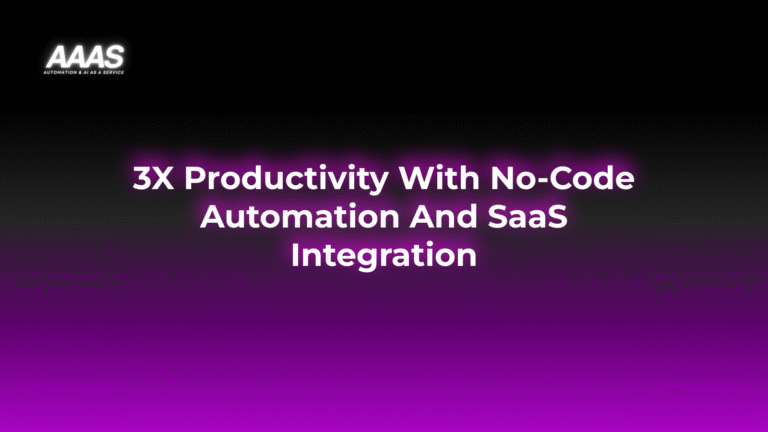Leveraging No-Code Automation and AI Integration for Streamlined SaaS Workflows

Market Problem: The Challenge with SaaS Workflows
SaaS adoption has exploded, but teams often face:
- Manual, repetitive tasks that drain productivity
- Disconnected tools causing workflow bottlenecks
- High integration costs for custom code solutions
- Slow adaptation to changing process requirements
Legacy approaches to optimizing workflows—custom scripting, API development, manual syncs—are resource-intensive, inflexible, and unsustainable as SaaS stacks grow.
Solution & Key Benefits of No-Code Automation and AI
No-code automation platforms (e.g., Make, Zapier, n8n) combined with AI-powered workflow tools (like Google AI or OpenAI) empower anyone—not just developers—to build, integrate, and optimize SaaS workflows, enabling:
- Faster productivity gains through drag-and-drop interfaces
- Seamless SaaS integrations across marketing, sales, support, and ops
- AI-enhanced decision making (auto-tagging, prioritization, content generation)
- Massive cost reduction by eliminating manual tasks and custom code maintenance
- Scalable, flexible processes that adapt as business needs change
For further reading on the value of no-code, see Harvard Business Review: The Rise of No-Code and Low-Code Platforms.
Real-World Use Cases
- Marketing: Auto-enrich leads with AI, synchronize contacts between CRM and email, generate campaign reports
- Sales: Qualify inbound leads using GPT-based chatbots, trigger follow-up sequences in HubSpot
- Customer Support: Assign tickets by sentiment analysis, auto-reply to common queries, escalate based on AI-detected urgency
- Product: Sync feature requests from Intercom to Jira, summarize customer feedback with AI
- Finance/Ops: Monitor subscriptions, auto-generate invoices, detect anomalous transactions
See our Automation Examples Library for sector-specific workflows.
Technical Details: Enabling No-Code and AI Integration
No-Code Automation Platforms
- Zapier: Connects 6,000+ SaaS tools with intuitive automation (zaps)
- Make (Integromat): Powerful, visual scenario builder—handles complex logic
- n8n: Open-source, self-hostable, extensive customization
AI Service Connections
- OpenAI, Google Cloud AI, Microsoft Azure AI—integrate via pre-built or custom modules
- Native AI features in modern no-code platforms (text classification, summarization, recommendations, image generation, etc.)
Automation Triggers and Actions
Automations can be triggered by:
- Webhook events (new lead, support ticket, form submission)
- Scheduled runs (daily report generation, data sync)
- Conditional logic (if churn risk score > 80%, alert account manager)
Actions include record creation, notification, enrichment, document generation, and more.
Comparison with Alternative Approaches
| Solution | Speed to Launch | Technical Skill Needed | Maintenance | Cost |
|---|---|---|---|---|
| No-Code Automation & AI | Minutes-Hours | None-Low | Low | Low-Medium |
| Custom API Development | Weeks-Months | High (Developers) | High | High |
| Manual Processes | Instant | None | High (Human errors) | Hidden High |
Pricing Comparison of Leading Tools
| Platform | Free Tier | Business Pricing (Monthly) | Key Limitations |
|---|---|---|---|
| Zapier | ✅ | From $49.99 | Usage caps, premium features require upgrades |
| Make (Integromat) | ✅ | From $18 | Execution limits, advanced logic on higher tiers |
| n8n | ✅ (Self-hosted) | Cloud: From €20 | Setup complexity (self-hosting) |
| OpenAI API | Limited | Pay-as-you-go (~$20+/mo typical use) | Pricing by usage/token volume |
ROI-Focused Practical Examples
Example 1: Automated Lead Enrichment
- Manual cost: 10 min/lead × 500 leads/mo × $25/hr = $2,083/mo
- No-code+AI cost: $50/mo (Zapier+OpenAI)
- ROI: $2,033 saved per month
Example 2: AI-Powered Support Ticket Triage
- Manual triage: 5 min/ticket × 800 tickets/mo × $20/hr = $1,333/mo
- No-code+AI cost: $60/mo
- ROI: $1,273 saved per month
How to Set Up No-Code Automation with AI Integration
- Document your existing workflows; identify repetitive manual tasks
- Choose a no-code platform (Zapier, Make, n8n) and create an account
- Connect your SaaS tools via provided integrations or API keys
- Add AI modules (e.g., OpenAI API) for enhanced logic, content, or classification
- Build your workflow visually (trigger ➔ steps ➔ action/AI decision ➔ output)
- Test with sample data; iterate for reliability and accuracy
- Deploy and monitor automation performance
For advanced tips, see Best No-Code Automation Practices.
Pros & Cons
| Pros | Cons |
|---|---|
|
|
Expert Tips for Maximizing Results
- Start simple: automate high-impact, low-complexity tasks first
- Use version control or documentation for your workflows
- Continuously monitor and refine AI-driven steps for edge cases
- Leverage templates and the automation community for inspiration
- Plan for scale—segment workflows and avoid monolithic automations
Discover more effective strategies in our Automation Strategy Guide.
Frequently Asked Questions
- Is no-code automation secure for sensitive company data?
- Leading platforms offer robust security, encryption, and compliance. Review each tool’s security documentation and consider self-hosted options (e.g., n8n) for maximum control.
- How much AI can I use with free/entry-level plans?
- Most free plans support basic workflow steps and limited AI/API calls. For production use, consider paid tiers to unlock higher usage and advanced features.
- Can I integrate custom or niche SaaS tools?
- Most platforms allow custom webhooks, HTTP modules, or direct API integration, supporting even lesser-known SaaS products with minimal coding.
- What if my workflow fails?
- Use built-in error handling (retries, alerts) and monitor your automation dashboards to catch and resolve issues promptly.
References & Citations
Last Updated
2025-07-31T09:01:02.730Z







